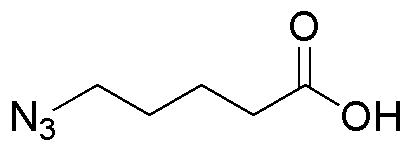5-Azidopentanoic acid is widely utilized in research focused on:
- Bioconjugation: This compound serves as a versatile linker for attaching biomolecules, such as proteins or peptides, to surfaces or other molecules, enhancing the development of targeted drug delivery systems.
- Click Chemistry: Its azide functional group allows for efficient click reactions, making it valuable in synthesizing complex organic compounds and materials in a straightforward and reliable manner.
- Polymer Chemistry: Used in the production of functionalized polymers, it helps create materials with specific properties for applications in coatings, adhesives, and biomedical devices.
- Fluorescent Probes: The compound can be incorporated into fluorescent probes, aiding in imaging techniques for biological research, which helps visualize cellular processes in real-time.
- Drug Development: Its unique structure allows for modifications that can lead to the discovery of new pharmaceutical agents, particularly in the field of anti-cancer therapies.
General Information
Properties
Safety and Regulations
Applications
5-Azidopentanoic acid is widely utilized in research focused on:
- Bioconjugation: This compound serves as a versatile linker for attaching biomolecules, such as proteins or peptides, to surfaces or other molecules, enhancing the development of targeted drug delivery systems.
- Click Chemistry: Its azide functional group allows for efficient click reactions, making it valuable in synthesizing complex organic compounds and materials in a straightforward and reliable manner.
- Polymer Chemistry: Used in the production of functionalized polymers, it helps create materials with specific properties for applications in coatings, adhesives, and biomedical devices.
- Fluorescent Probes: The compound can be incorporated into fluorescent probes, aiding in imaging techniques for biological research, which helps visualize cellular processes in real-time.
- Drug Development: Its unique structure allows for modifications that can lead to the discovery of new pharmaceutical agents, particularly in the field of anti-cancer therapies.
Documents
Safety Data Sheets (SDS)
The SDS provides comprehensive safety information on handling, storage, and disposal of the product.
Product Specification (PS)
The PS provides a comprehensive breakdown of the product’s properties, including chemical composition, physical state, purity, and storage requirements. It also details acceptable quality ranges and the product's intended applications.
Certificates of Analysis (COA)
Search for Certificates of Analysis (COA) by entering the products Lot Number. Lot and Batch Numbers can be found on a product’s label following the words ‘Lot’ or ‘Batch’.
*Catalog Number
*Lot Number
Certificates Of Origin (COO)
This COO confirms the country where the product was manufactured, and also details the materials and components used in it and whether it is derived from natural, synthetic, or other specific sources. This certificate may be required for customs, trade, and regulatory compliance.
*Catalog Number
*Lot Number
Safety Data Sheets (SDS)
The SDS provides comprehensive safety information on handling, storage, and disposal of the product.
DownloadProduct Specification (PS)
The PS provides a comprehensive breakdown of the product’s properties, including chemical composition, physical state, purity, and storage requirements. It also details acceptable quality ranges and the product's intended applications.
DownloadCertificates of Analysis (COA)
Search for Certificates of Analysis (COA) by entering the products Lot Number. Lot and Batch Numbers can be found on a product’s label following the words ‘Lot’ or ‘Batch’.
*Catalog Number
*Lot Number
Certificates Of Origin (COO)
This COO confirms the country where the product was manufactured, and also details the materials and components used in it and whether it is derived from natural, synthetic, or other specific sources. This certificate may be required for customs, trade, and regulatory compliance.

